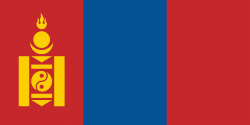Uliastai (Uliastay)
Uliastai (Улиастай; ), also spelled Uliyasutai or Oulia-Sontai, and sometimes known as Javkhlant, is a city in Mongolia located in the western part of the country and 1,115 km from the capital Ulaanbaatar. Uliastai is the capital of Zavkhan Province and was the 10th most populous city in the country with a population of 24,276 (2000 census). However, recent estimates have the city's population at 16,240 (. ) making it the 16th most populous city in Mongolia.
Uliastai is located in a river valley where the Chigestai and Bogdiin Gol rivers meet, and is surrounded by mountains on all sides. It is one of the most remote aimag capitals in Mongolia. Uliastai city has sum (district) status and forms an enclave within the surrounding Aldarkhaan sum.
Alongside Khovd, Uliastai is one of the oldest settlements in Mongolia, and has long been an important center of caravan trade even into the 20th century. It was connected by camel caravan routes with Urga (now Ulaanbaatar) in the east, Khovd in the west, Barkol and other points in Xinjiang in the southwest, and Hohhot in the southeast.
The city was founded as a military garrison by the Manchus in 1733 during the Qing rule of Mongolia. Uliastai was the de facto capital of Outer Mongolia, as the Qing Amban, the Governor General, located its office in Uliastai to keep eye on the Khalkh Mongols to the east and the Oirad Mongols west of the Khangai mountains. At its peak, the fortress held up to 3500 soldiers and was surrounded by a Chinese trading quarter, or "Maimaicheng".
In March 1755, a Qing dynasty army departed from Uliastai as the vanguard in the Qianlong Emperor's final push against the Dzungar Khanate to the south west.
During the Outer Mongolian Revolution of 1911 the Military Governor of Uliastai, his staff, and military guards, fled the Uliastai fortress under the protection of Cossack troops. Traces of Manchu rule can still be seen in Uliastai: the stone remnants of the governors fortress near the Bogdiin river are a short walk from town, the shackles and torture devices used by the Manchu are on display in the History Museum, and a hatag-laden stone near the central roundabout is carved with Chinese characters.
Uliastai is located in a river valley where the Chigestai and Bogdiin Gol rivers meet, and is surrounded by mountains on all sides. It is one of the most remote aimag capitals in Mongolia. Uliastai city has sum (district) status and forms an enclave within the surrounding Aldarkhaan sum.
Alongside Khovd, Uliastai is one of the oldest settlements in Mongolia, and has long been an important center of caravan trade even into the 20th century. It was connected by camel caravan routes with Urga (now Ulaanbaatar) in the east, Khovd in the west, Barkol and other points in Xinjiang in the southwest, and Hohhot in the southeast.
The city was founded as a military garrison by the Manchus in 1733 during the Qing rule of Mongolia. Uliastai was the de facto capital of Outer Mongolia, as the Qing Amban, the Governor General, located its office in Uliastai to keep eye on the Khalkh Mongols to the east and the Oirad Mongols west of the Khangai mountains. At its peak, the fortress held up to 3500 soldiers and was surrounded by a Chinese trading quarter, or "Maimaicheng".
In March 1755, a Qing dynasty army departed from Uliastai as the vanguard in the Qianlong Emperor's final push against the Dzungar Khanate to the south west.
During the Outer Mongolian Revolution of 1911 the Military Governor of Uliastai, his staff, and military guards, fled the Uliastai fortress under the protection of Cossack troops. Traces of Manchu rule can still be seen in Uliastai: the stone remnants of the governors fortress near the Bogdiin river are a short walk from town, the shackles and torture devices used by the Manchu are on display in the History Museum, and a hatag-laden stone near the central roundabout is carved with Chinese characters.
Map - Uliastai (Uliastay)
Map
Country - Mongolia
 |
|
| Flag of Mongolia | |
The territory of modern-day Mongolia has been ruled by various nomadic empires, including the Xiongnu, the Xianbei, the Rouran, the First Turkic Khaganate, and others. In 1206, Genghis Khan founded the Mongol Empire, which became the largest contiguous land empire in history. His grandson Kublai Khan conquered China proper and established the Yuan dynasty. After the collapse of the Yuan, the Mongols retreated to Mongolia and resumed their earlier pattern of factional conflict, except during the era of Dayan Khan and Tumen Zasagt Khan. In the 16th century, Tibetan Buddhism spread to Mongolia, being further led by the Manchu-founded Qing dynasty, which absorbed the country in the 17th century. By the early 20th century, almost one-third of the adult male population were Buddhist monks. After the collapse of the Qing dynasty in 1911, Mongolia declared independence, and achieved actual independence from the Republic of China in 1921. Shortly thereafter, the country became a satellite state of the Soviet Union, which had aided its independence from China. In 1924, the Mongolian People's Republic was founded as a socialist state. After the anti-communist revolutions of 1989, Mongolia conducted its own peaceful democratic revolution in early 1990. This led to a multi-party system, a new constitution of 1992, and transition to a market economy.
Currency / Language
| ISO | Currency | Symbol | Significant figures |
|---|---|---|---|
| MNT | Mongolian tögrög | ₮ | 2 |
| ISO | Language |
|---|---|
| MN | Mongolian language |
| RU | Russian language |















